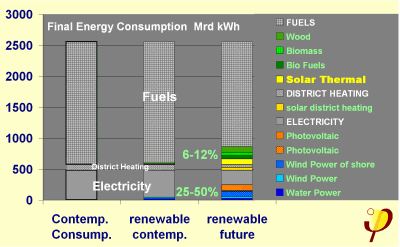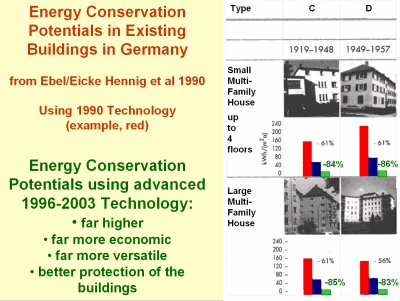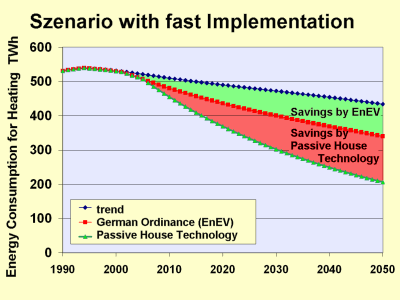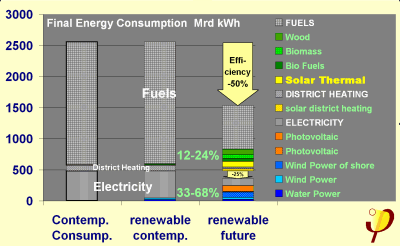| |
Implementation of energy efficiency in old buildings
Positioning in the pattern of energy
consumption
Fig. 1 shows the current total energy use in Germany,
subdivided into combustibles (hydrocarbon fuels), district heating
and electricity [Arge 2001]). Combustibles and hydrocarbon fuels
contribute the main share (78%) of German energy supply, followed
by electricity with a share of 18 % and and district heating with
4 %. For a better distinction, the respective share of renewable
energy has been highlighted in the diagram using some colour. Nowadays,
the percentage of electricity generated by renewable energy sources
is after all about 9%. A much higher share of renewable energy than
in the field of substituting combustibles, with only one per cent
of firewood and thermal utilisation of solar energy (water heating)
still in a very low range. Even optimistic future estimations of
increasing the use of renewable energy sources in this field by
6 to 9 % is not sufficient in compliance with climate protection
goals. At least, as long as today`s level of consuming combustibles
and hydrocarbon fuels is taking into acccount. That is precisely
where energy efficiency technology can make a vital contribution
to increasing the share of renewable energy sources- by increasing
the efficiency of energy usage.
Improved energy efficiency in the
field of heating
The basic approach of modernising existing buildings by means of
highly efficient elements, has already been presented at the 3rd
Conference on Passive Houses in Bregenz. It is of utmost importance
to significantly improve the energetic quality of each component
that is being modernised. Always acting on the maxim “if you’re
going to do something at all, you might as well do it properly”.
Passive House technology mainly pushed the development of new, energy-saving
components in the last ten years. The importance of such new components
according to energy saving potentialities in already existing buildings
is shown in figure 2. Here, multi family residences
in the period of 1919-1948 and 1949-1957 (former FRG ) have been
singled out.
Up to the year 1990, it was possible with the availabe technologies
to achieve economically sound energy saving potentialities (costs
of saved energy about 0,065 €/kWh) of approximately 60 %, compared
to the actual state of the buildings. Carefully taken measures led
to annual heat reqirements of 65 to 90 kWh (m²a). Thereby meeting
the standard of low energy houses.
The green columns in in figure 2 on the far
right show the possible annual heat requirement after modernising
the respective building by means of today’s Passive House
technology. With only 25 to 35 kWh/(m²a), the annual heat requirement
was again reduced to less than half of what it has been before.
Thereby achieving possible energy savings of 80 to 90 %.
Updated scenarios as shown in figure 3 result
from estimations on further high rates of implementation and modernisation,
based on the total heating demand of reunited Germany in the year
2000. The old “trend-scenario” (see Ebel 2000) needs
to be compared to the effects of new terms and regulations in the
EnEV 2002 (energy saving ordinance). Due to higher demands on windows,
thermal insulation and re-fitting duties, we are forecasting an
already noticable reduction of the energy requirement in comparison
to the old trend-scenario. Thanks to the availability of Passive
House elements ( “new technology”), this potential will
be more than doubled again.
Conclusion
The results of realised projects demonstrate that
with today’s available Passive House components it is possible
to achieve annual heat requirements of 25 kWh/(m²a) even in
the stock of already existing buildings [AkkP24]. If visual cladding
or regulations of monumental protection make an insulation at the
external surface impossible, 60 kWh/(m²a) can still be achieved
by internal insulation. Thereby, acting on the maxim that a carefully
planned inner insulation is better than no insulation at all. Such
measures have been the topic of the research group’s 32nd
meeting [AkkP 32 (German)] . Dabei gilt der Grundsatz, dass eine sorgfältig
geplante Innendämmung besser ist als keine Dämmung.
The existing potentialities make clear that it is possible to improve
the quality of the building stock immensely in the decades to come,
provided that an engaged programme of modernisation is initiated.
Thus making it possible to reduce the heating energy consumption
in total to less than 50 % of what it is today. Already taking into
account the small stock of buildings, where modernisation is not
possible. Against the background of immensely improved energy efficiency,
potentialities of renewable energy sources (see Fig.
1) can now be newly judged. More efficient systems (buildings,
facilities and vehicles) lead to strongly reduced energy demands.
Thus, renewable energy sources can reach a significant share in
total energy supply ( see Fig. 4).
The utilisation of the potentialities takes place at a local and
regional level. What are suitable instruments to proceed further
on this road, what are model projects and examples and what experiences
have been made. These questions will be subject of
Working
group no. XIV: Implementation
within the region and the municipalities.
Literature:
[Arge 2001] Arbeitsgemeinschaft Energiebilanzen:
Auswertungstabellen zur Energiebilanz für die Bundesrepublik Deutschland
1990 bis 2000, Ausgabe 2001. (German)
[Ebel 2000] Ebel, W.; Eicke-Hennig, W.; Feist, W.; Groscurth, Helmuth-Michael:
Energieeinsparung bei Alt- und Neubauten, 1. Auflage, Heidelberg,
2000. (German)
[AkkP 24] Passivhauskomponenten
im Gebäudebestand , Protokollband Nr. 24 des Arbeitskreises
kostengünstige Passivhäuser Phase II, Passivhaus Institut
(German)
[AkkP 32] Passivhauskomponenten
und Innendämmung, Protokollband Nr. 32 des Arbeitskreises
kostengünstige Passivhäuser Phase II, Passivhaus Institut
(German)
(Author: Dr. Wolfgang Feist; abstract derived from [AkkP 24])
You want to submit a paper? Find more
Information
here.
Time
schedule of the 10th International Conference on Passive Houses
in Hannover
2005 Dezember 1st:
Deadline for abstracts
2006 February 1st: Notification on acceptance
of abstracts
2006 March 1st: Registration
period for reduced fee ends
2006 March 15th: Deadline for
the written contributions of the preceedings
2006 May 19th
and 20th 10. Conference on Passive Houses HCC Hannover
with Exhibition
on Passive House Components and
manufacturers
session
May 21st
field trip to the most interesting Passive House projects and construction
sites incl. refurbishment in the region near Hannover.
(updated:2005-09-23 ©
Passivhouse Institute PHI; this page might be reprinted if unchanged)
The PHI is
not responsible for the content of linked web-pages.
Passive
House Institute, Dr. Wolfgang Feist. mail@passiv.de. |





 PDF 283 kb
PDF 283 kb